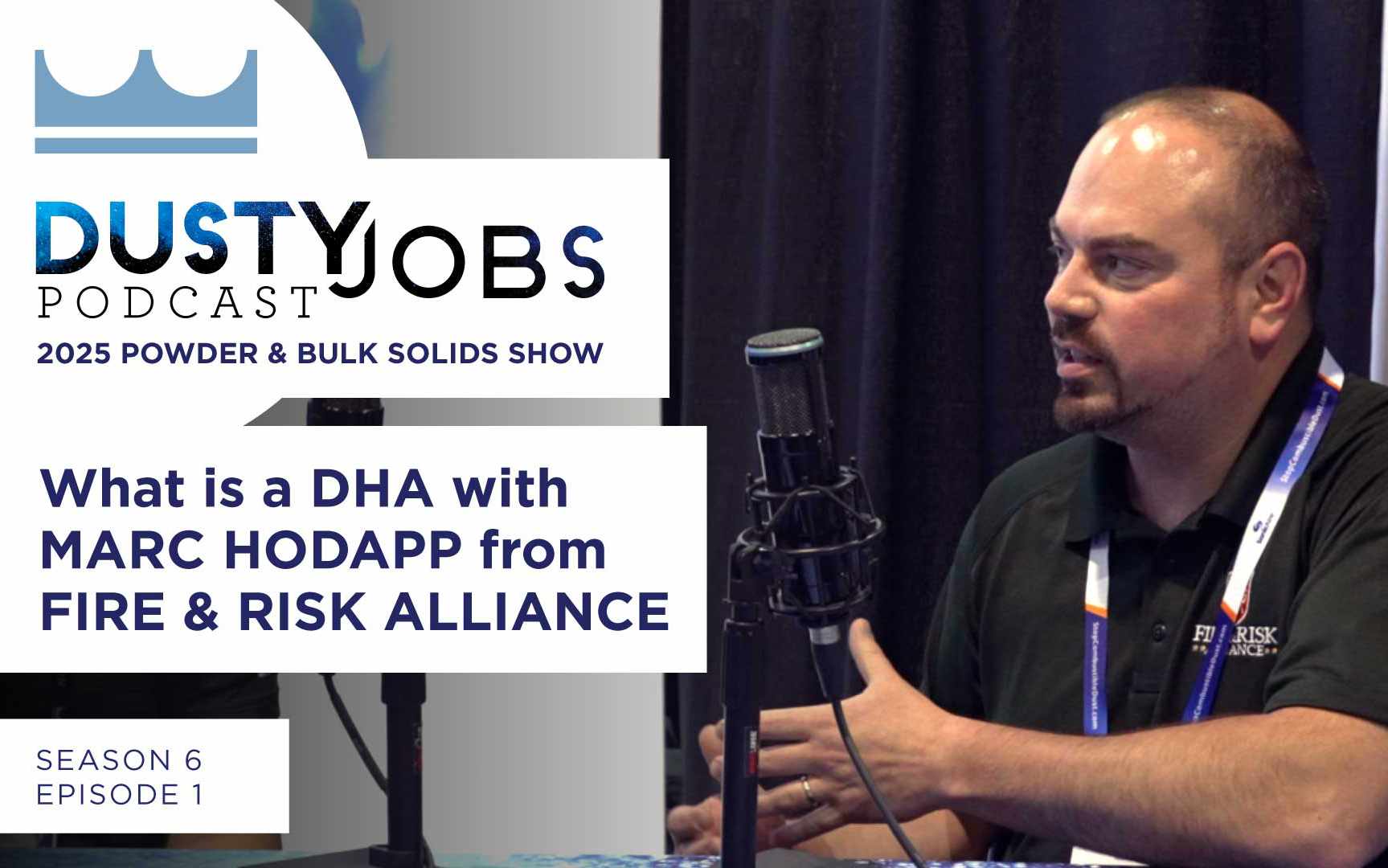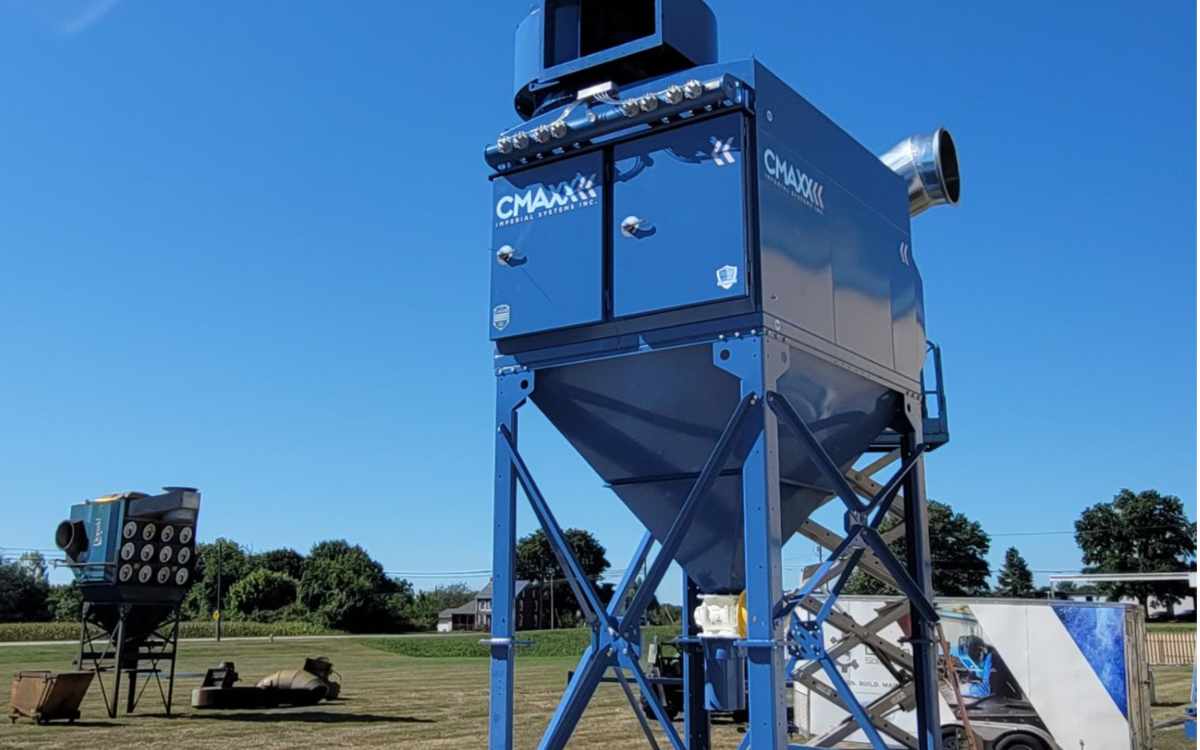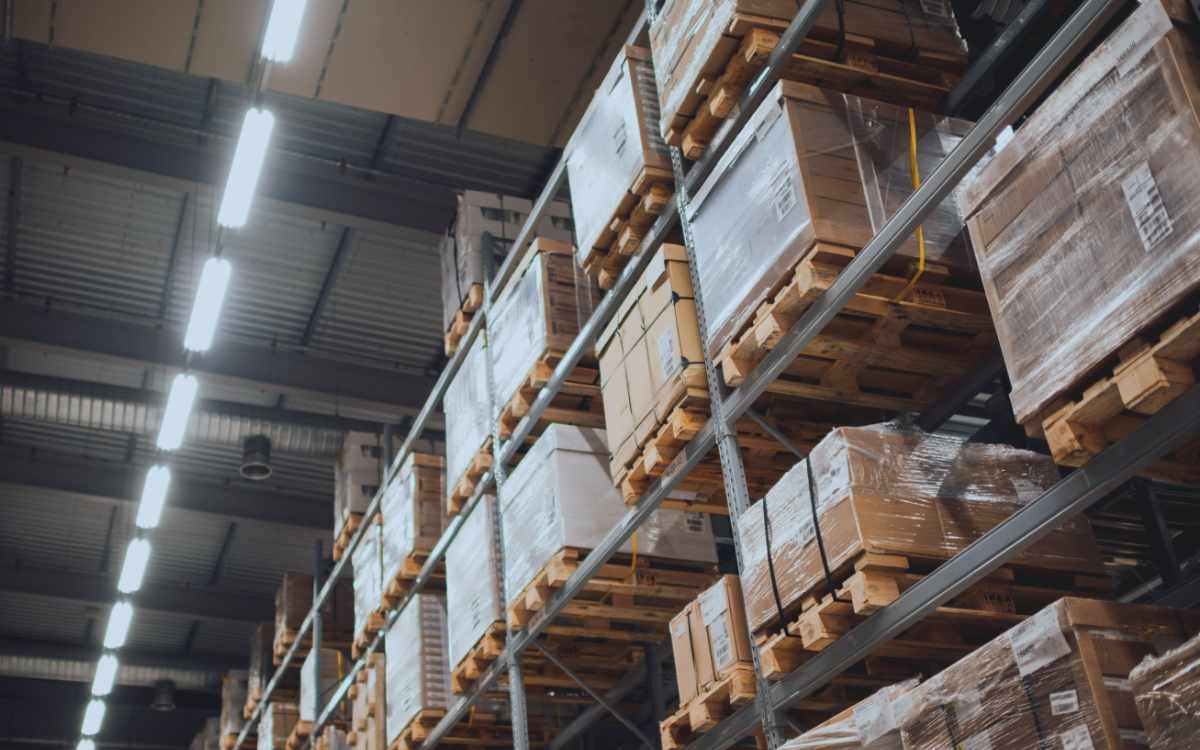We are back in our booth at the International Powder and Bulk Solids Show in Chicago. For this episode we meet with Jim Peters from Boss Products. Jim tells us about what Boss products does, and goes into detail about one of their more popular products. He talks about the NRV (Non Return Valve) and the Vigiflap and how they are used in an explosive dust system. He explains the different orientations and situations to install these devices in a dust collection system to ensure safety in the event of a combustible dust event.
Narrator: Welcome to the Dusty Jobs Podcast from Imperial Systems. Industry knowledge to make your job easier and safer.
Donovan: Hello and welcome to another episode of the Dusty Jobs podcast. We’re here again still live at the Powder Bulk Solid Show in Chicago. Joining us now is Jim Peters from Boss Products. How are you doing today?
Jim: I’m doing good.
Donovan: That’s great. So you guys also have a booth here, right?
Jim: We do. 2714 for anybody who is still here and wants to go.
Donovan: Gotcha.
Jim: We’re there.
Donovan: Swing by.
Jim: Please.
Donovan: See you guys. Jim will get you some candy or something, right?
Jim: We got no candy.
Donovan: You’ve got no candy? That’s all right.
Jim: Oh no, wait. Wait a minute. But if you come by, we’ll find candy. We’ll find you some candy.
Donovan: Sounds good, sounds good. So, you have been with Boss Products for how long now?
Jim: Officially since 2017.
Donovan: Right, but you’ve been in this industry for a long time.
Jim: I’ve been in this industry for over 40 years.
Donovan: Oh, wow.
Jim: Yeah, yeah. I go back before computers with this. I had an Apple IIe sitting on my desk to design negative air lift systems in flour mills.
Donovan: Oh wow.
Jim: Yeah it was so slow that you had to lock the data keys or lock the calculation keys, key in all the lift parameters then you could go to lunch and literally 30 minutes later come back and it would just be wrapping up a mill calculation.
Donovan: There you go.
Jim: So yeah that’s how long I’ve been doing this.
Donovan: Yeah so you have a little bit of knowledge.
Jim: Some.
Donovan: Yeah.
Jim: The more you know the less you know for sure.
Donovan: So, so that’s a little bit about you. Now, Boss, Boss has been around for a while.
Jim: Boss has been around since 2012.
Donovan: Yeah.
Jim: Officially as Boss Products.
Donovan: So, anybody who doesn’t know what Boss Products is or who Boss Products is, what, tell us a little bit about you guys. What you got, what your company does.
Jim: Sure. Boss Products specializes in ATEX certified fire and explosion safety mitigation equipment. Basically, we’re North American distributors for several European companies that are all ATEX certified manufacturing. Their products are ATEX certified manufactured and then we buy in great quantities and represent them here and do the distribution from our plant from our warehouse in San Antonio, Texas.
Donovan: Yeah but you guys are more than just you know buying and reselling products you guys have a knowledge base everybody in your group seems like they’ve been in the industry for a while like yourself and and you know what they’re talking about.
Jim: Yeah our owners, our owners go back decades. I mean we have, I think, Peter Schlantz, the owner, the father, Peter and Nick are the two owners and they go back to manufacturing base in dust collection.
Donovan: Right.
Jim: Nick grew up putting ductwork in as a teenager and so everybody here has got a background. There’s no, no one is learning as we go.
Donovan: There you go. There you go. Except me. I’m learning as we go along this podcast.
Jim: Okay. I don’t know how to do podcasts. So you know more than I do about that.
Donovan: You’re doing great. So let’s talk about what a couple of your guys’ main products are.
Jim: Sure.
Donovan: So you guys really focus in on explosion protection.
Jim: Correct.
Donovan: So that’s providing safety equipment for people who are working around explosive dust, working around a dust collector, that is containing the explosive dust.
Jim: Yeah, I know. Explosion isolation and passive isolation valves is one of the primary items that we sell.
Donovan: I gotcha.
Jim: And that goes back to that 2012 starting date. The first item in Boss Products was the the NRV, the no return valve that they purchased from a company in Italy.
Donovan: Right. And it’s pretty basic. I mean, it’s very doesn’t allow things to return to the facility. It’s a no return valve.
Jim: It’s yeah, it’s basically an no return valve. NFPA would categorize it as a passive flat valve.
Donovan: Okay.
Jim: And basically it’s closed by the pressure front coming from an explosion in a vessel.
Donovan: Gotcha. Gotcha. So how’s it open? How’s it held open?
Jim: It’s held open. Yeah, the flap valves like this are held open traditionally anyway have been held open on the air stream. The airflow keeps the valve just passes under the valve, the flap of the valve and holds it open. The pressure front works way more pressure than there is holding the valve open comes and slams it shut.
Donovan: So there’s a certain amount of air that will be flowing through the duct.
Jim: Correct.
Donovan: It holds the flap open.
Jim: Correct.
Donovan: But then when something happens in the dust collector
Jim: Then you have the you have a flame or a pressure front that moves at about the speed of sound. And that is followed very closely by a fireball. or a series of fireballs that consume the fuel in the ductwork. If it goes unchecked it’ll just continue to consume fuel as it goes and multiply in intensity.
Donovan: Right, the whole way back to where workers are.
Jim: All the way back to where the workers are and then that will in turn if left unchecked it’ll dislodge dust that’s on machinery, on beams up above. It becomes all the housekeeping issues that you may have will all of a sudden become your best nightmare because all that dust becomes fuel for a really big secondary explosion.
Donovan: Right, right. I mean we’ve seen some of that happen.
Jim: Yeah that’s usually the one that gets the plant that takes it.
Donovan: Yeah, but so your valve what it is is so it’s in line in that dust collector And when that pressure wave comes back that pressure wave before the flame gets there.
Jim: Correct. It slams it shut it locks it and then then you’ll see and we have some rapid camera videos basically slow-motion videos. You can see that flame front get almost to the valve or get part of the way to the valve and then just recede back into the vessel and hopefully if your dust collector is properly vented or then that pressure and that flame front is released even through the vent or through a flameless vent or whatever the…
Donovan: To a safe direction.
Jim: To a safe direction.
Donovan: Hopefully where nobody is present.
Jim: Without taking, without damaging the dust collector.
Donovan: Right.
Jim: Yeah.
Donovan: Right.
Jim: So that’s that’s yeah, that’s the basics of where we started was with that NRV.
Donovan: Yeah, so that was the the very first version of that right?
Jim: Correct.
Donovan: Now you guys have a second version of that now correct?
Jim: There’s a second version of the NRV from the same from that same manufacturer and there’s also a similar a similar piece of equipment from another manufacturer in France that is we feel like both have a place they both have their own applications and their own strong points and advantages disadvantages but the Vigiflap…
Donovan: Now that’s the name of the new one right?
Jim: That’s the name of the new one okay so we have the NRV which is the older style and we have the Vigiflap.
Donovan: Okay, I’m with you.
Jim: The Vigiflap is also a passive flap valve. Falls under the same regulations as the NRV. The difference has been the testing that they ran and the design has allowed them to place the valve in a couple of different orientations in the NRV or pretty much any other passive flap valve on the market.
Donovan: Okay, so what are these new positions you can put it in? What are we talking about?
Jim: For one, you can do it in a vertical pipe.
Donovan: Oh, okay.
Jim: Which is a big advantage in real world placement of these isolation valves. You can’t always get it into a horizontal oriented duct and stay within the parameter.
Donovan: Just doesn’t allow it to be there, whatever the duct layout is.
Jim: Yeah, that’s right.
Donovan: What allows you to put it in that vertical position?
Jim: They’ve built a locking mechanism into the valve. So when it’s in a vertical position then the valve was tested and certified with the flap in a locked open position.
Donovan: But if it’s locked how does it close?
Jim: Yeah it’s calibrated. The locking is done by a spring steel mechanism. Okay. Kind of a cam of arrangement and a spring steel and it’s calibrated so that the pressure front that closes the valve is easily overcomes that that lock position.
Donovan: So it’s got enough to hold the flap up but not enough to hold it up under pressure.
Donovan: That’s right. That’s right. The other thing that it can do and again it’s in the lock position but the other thing it can do is it can protect the clean side or the the discharge side of the of the dust collector.
Jim: Which the NRV cannot do that. Yeah, as far as I know no other, I don’t think there’s any other flap valve that does it. You basically reverse the reverse the flap valve so that the air is instead of holding the flap open like we were talking about earlier, the locking mechanism is holding the flap open. The air basically impinges on the the lead edge of the blade itself but with the open, with it locked open, it’s still kept open against that, against that movement of air. Right. But again, the pressure wave locks the valve shut.
Donovan: So the air is not strong enough to cause it to close. It’s still able to held open until the pressure wave causes it to close.
Jim: That’s right. Yeah, correct. Yeah. It takes a little more, as far as the parameters for the placing the valves with these, with these options takes a little more of a minimum distance.
Donovan: So you have a shorter distance with the with the NRV?
Jim: With the NRV, Yeah, it does have a shorter distance with the NRV but one advantage either one can be placed indoors you know you’re not you’re not it’s not mandatory that the valves be outdoors because they are an explosion they’re built to hold the explosion in intact but on the the Vigaflap, one advantage you do have in addition to being able to put it in the vertical is you can it’s got a very long maximum distance. So say you you have to go around an elbow to the vertical and then an elbow in and and you’ve already gone you’ve already gone further than the L minimum and there’s no place else to put it you can go 50, I believe it’s 57 feet.
Donovan: So if your spacing doesn’t allow for that valve to fit in, you can go further away.
Jim: You can go further away. Yeah, that’s correct. And the same is true on either side, but that gives you protection for both inlet and outlet if you’re returning the air, keeps the explosion from propagating back through either way.
Donovan: Right, whether you’re returning the air to the building or the air coming into the collector.
Jim: Correct,
Donovan: So why would what would cause me to choose one over the other when I’m looking at sure an NRV or a Vigiflap? How do I determine which one I need?
Jim: Price-wise they’re very similar. So it’s not really that. The NRV has one advantage, one big advantage in that It’s recently been redesigned, reconfigured a bit. So they’ve made it, the locking mechanism is a double locking and it’s a little more robust, I think than it was originally. They’ve gone through and done recertification, retesting.
Donovan: Okay.
Jim: The new certificates are allowing for a minimum distance from the flange of the inlet of the dust collector at three meters.
Donovan: Oh, so you can put those real close.
Jim: You can put them within 10, you know, like 10 feet.
Donovan: Yeah.
Jim: They still have a little more restriction. They’re only in the horizontal. You can use an elbow in between, which is an improvement now. So that may be one reason you do use the NRV. Another would be, they have done the certification for the ATEX certification for the NRV, all the way up from four inch, all the way up to 48 inch.
Donovan: Oh, okay. So it has a really large range of certification.
Jim: A really large range of certification.
Donovan: Now when you say that certification what does that I mean is that a KST value it goes up to or is it what what are we looking at when you get that certified?
Jim: When you get that certified they do testing where they they run it they run explosions in a vessel with with the the valve in a system. They confirm that they test it to a certain KST value and they confirmed that the valve actually does its job. It actually does the isolation within a certain distance parameters and up to a certain KST. So basically this is one of the nice things about our jobs. We get to see things get blown up. But yeah, when you get the certificate for every size there is a range of distances, there’s a range of KSTs, a range of P-maxes that they’re certified and tested for.
Donovan: So it’s unique to each size, you just look at the manual or whatever documents you guys have to tell you which ones.
Jim: Which is why you see like a spreadsheet of parameters and they’re different for every, basically different for every size. The new the new NRV combos, they could they’re called the new combos I think are all I believe they’re all three meters. I think that the 22 may be the exception I think it’s three and a half meters.
Donovan: So that’s an advantage over the Vigiflap?
Jim: It is, yeah. The disadvantage, one of the places I would definitely use the the Vigiflap over the NRV. Okay. If you look at the design of the the Vigiflap versus the the NRV. The NRV. is basically a box. Right. It’s a box with inlet and outlet transitions and kind of kind of like driving a cement block down the highway. It is not aerodynamic, it’s not it’s not sanitary, it’s good for things like wood and you know things that don’t have a great have a build-up or requirement for sanitary design. It’s not it’s not good. The Vigiflap lap has a rounded contour. The bottom is rounded. The flap is domed so that it has a bit of a…
Donovan: So it has a little better flow properties to it.
Jim: A little better flow properties. The welds on it are robotic. Just a better, as far as sanitation, it’s a better valve in that case. And the disadvantage is that it is only certified, ATEX tested and certified from 6 to 32 inch. So that would be one disadvantage in that case.
Donovan: So you have a little bit more limited size?
Jim: A little bit more limited size.
Donovan: In the certification?
Jim: That’s correct.
Donovan: I mean, you can get them larger than that, though, correct?
Jim: Yeah.
Donovan: But they’re just not certified?
Jim: Yeah. They’re just not certified. And they do come, we do have manufacturers, a letter of, oh, what would you call it?
Donovan: Is it just saying that?
Jim: Just saying that it’s manufactured to the same standard.
Donovan: Right.
Jim: And it’s just a matter of testing you get in the queue and testing costs money and time.
Donovan: Right.
Jim: And they haven’t gotten to the point of doing that for the larger sizes.
Donovan: Oh, that’s understandable.
Jim: Yeah.
Donovan: Yeah. That’s still a big range that you have to pick from.
Jim: It is. They’re both available to 52 inch as a standard. The Vigaflap I know can be done bigger, can be done in 56 as a non-standard size. You can put wheels on them practically and drive them. They’re so big. That’s a large piece of equipment.
Donovan: That is.
Jim: No, there’s other advantages to each one. Those are the main ones really.
Donovan: So if somebody out here is listening, and what would be a reason that they should be thinking about getting one of these devices on their system currently? Like if they have, what kind of dust would you say you definitely should have one of these on?
Jim: Basically anything with a KST value greater than zero potentially, and that’s not to say that if you have a dust hazard analysis, a DHA run that you’re necessarily going to be required to have one. Right. Just because you have a combustible dust doesn’t mean that the DHA is going to come back and say you know that this is necessary but pretty much if you have a combustible dust anything would grain, any non-metallic, if it burns it could potentially explode. So if you have that then a passive system like we’re talking about, right, is probably the least expensive and the least expensive to maintain type of system.
Donovan: And you’re bringing up a good point to point out that this is an explosion protection. This is not a fire protection.
Jim: Yeah that’s correct. It’s not fire protection. It keeps that fireball from coming back in and setting off the secondary explosion.
Donovan: Right, but if you have a fire, this is not designed for that. It’s designed for an explosion.
Jim: That’s right. This does not mitigate your fire at all. And those things, we handle those things as well. Spark detect and extinguish. We do have some systems of fire suppression CO2 systems or dry chemical systems where you isolate the filter of vessel and detect a rapid temperature rise say or a rapid pressure rise and then you suppress a fire in the vessel itself.
Donovan: Now I have another question about the Vigiflap in the NRV though. So between the Vigiflap in the NRV. Is there a certain gauge of ductwork I should have on that?
Jim: Yeah, NFPA requires you to have a strong enough between the filter, between the protected vessel and the valve requires enough strength in the ductwork to withstand an explosion.
Donovan: Gotcha.
Jim: It’s always kind of a gray area as far as calling out an actual ductwork gauge.
Donovan: Gotcha.
Jim: One thing I’ve been told was if it’s the same gauge as the dust collector wall, you’re more than good.
Donovan: It’s probably a good starting point.
Jim: A good starting point, yeah. It wouldn’t need to be anything greater than a heavy gauge. It can definitely not be clamped together.
Donovan: Right.
Jim: It needs to be flanged.
Donovan: Bolted on there.
Jim: Yeah, bolted and full welded and flanged.
Donovan: Yep.
Jim: No spiral, no clamp together.
Donovan: Yeah, spiral duck would not do well under an explosion.
Jim: Would not do well. Probably 12 gauge, 14 gauge, probably good in most sizes.
Donovan: Yeah. So probably just the stronger the better.
Jim: The stronger the better, yeah. And that’s part of, when you talk about moving a valve out to a maximum distance, it is an extra cost.
Donovan: Right, because you gotta get that stronger duck work.
Jim: Yeah, exactly.
Donovan: So where that shorter distance might actually be a cost savings.
Jim: It might be a cost savings, exactly, yeah. But then, you know, safety, safety what’s the price. So you want the valve to be within the parameters, within the certified distances.
Donovan: Right.
Jim: And you want the safe duct work. So you have to kind of gauge that in your own budget.
Donovan: Yep, and there’s a lot of people to help with that. I mean, us here in Imperial, We’re pretty familiar with that. You guys are always willing to help people figure that out.
Jim: Yeah, we’re definitely willing to, we’ll do, try to help with layout and how can we get this valve into the L minimum, L maximum distances. Sometimes it takes another set of eyes to do that.
Donovan: Yeah. But in the end, Boss Products, Imperial Systems, we’re just trying to help people go home healthy and safe every day.
Jim: At the end of the day we want them to drive home.
Donovan: In the same condition they showed up to work or possibly better.
Jim: So well hey Jim thanks for coming on sure thanks for sharing more about this information. If anybody’s out there and they have had an explosion or think that they have a potential of one in their dust collector you know reach out to us reach out to you guys sure and let’s make sure everybody you know has a safer tomorrow because there’s technology out there that can help.
Donovan: That’s right.
Jim: You know, do better than we’re doing. But hey, well, thanks again for listening. Everybody who’s out there, you know, like and subscribe to us on all of the social medias. If you found us on YouTube, you can find us on Facebook, you can find us on everything that’s out there. And until the next time, stay healthy and stay safe.
Donovan: Donovan, thank you.
Jim: Yep.
Narrator: Thanks for listening to the Dusty Jobs Podcast. Breathe better, work safer.









